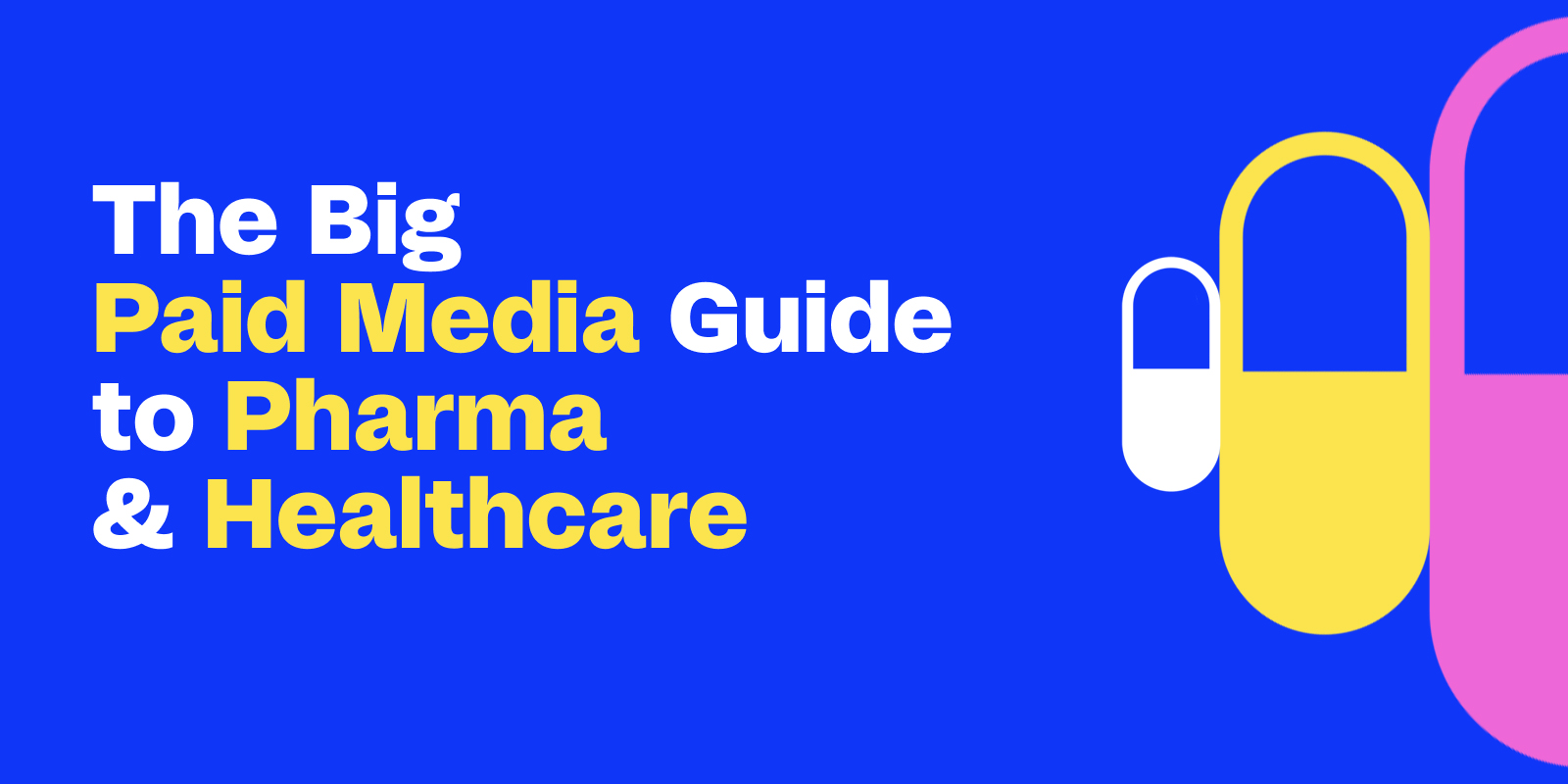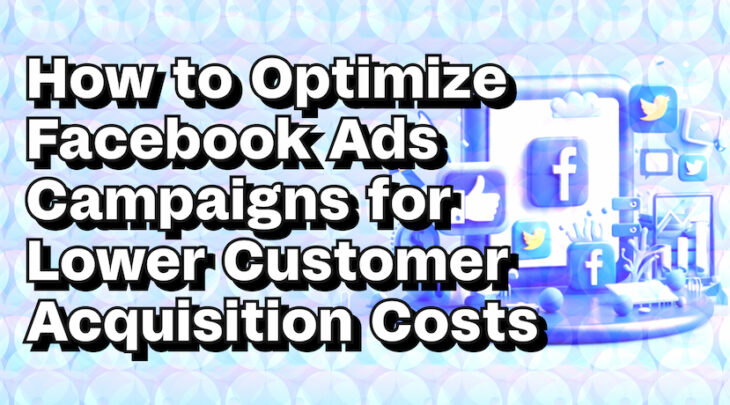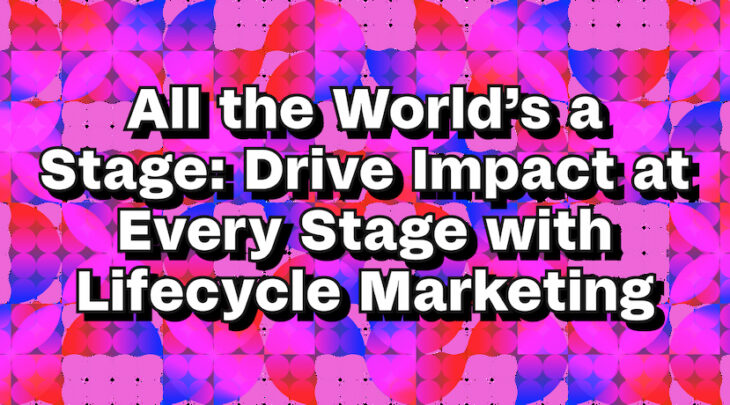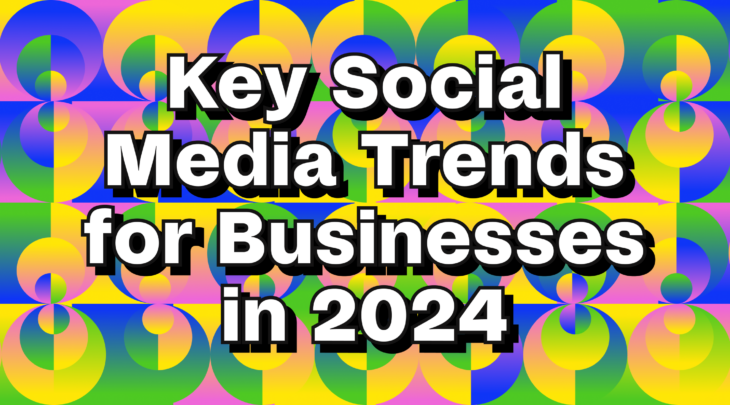Performance-driven paid pharma ads have transformed the healthcare and pharma industries the most in recent years. The pharma industry accounts for a significant portion of the total advertising spend, which has been steadily increasing in recent years. In 2022, healthcare ad spending is projected to surge more than 13%, potentially topping $300 billion for the first time. Research from Magna, a media investment and intelligence firm report that 37% of the marketers say this year’s budget is heftier than last year’s, 49% report flat budgets, and just 14% are facing decreases.
The balance between channels, audiences, and tactics is likely to remain fluid. The reason for this is that going forward, there will be a mix of live and virtual interactions between HCPs and patients, and that’s why strategic planning will be key to the brands’ successes. Moreover, pharma paid media marketing and advertising is different from standard paid marketing because of the extensive regulations and guidelines. It is important to understand the guidelines within the industry as violating them can result in severe penalties. Paid advertising platforms have an extensive list of guidelines that dictate what types of healthcare marketing techniques are and are not allowed.
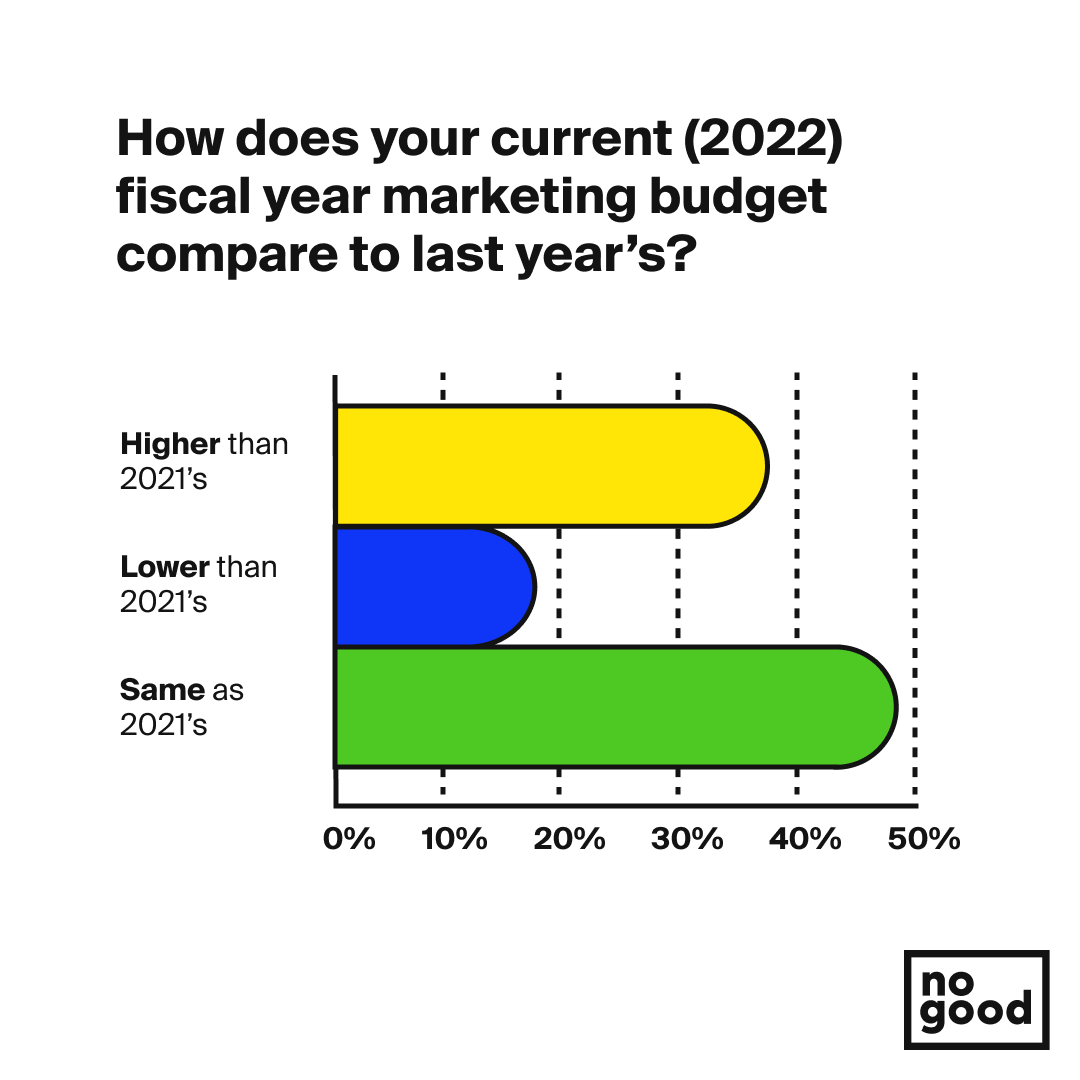
The Rules Of Running Pharma and Healthcare Paid Media Ads
A drug is considered “prescription-only” if its use by the patient must be supervised by medical professionals to ensure its safety. Prescription drug advertising in the U.S. is primarily overseen by the Food and Drug Administration (FDA), while the Federal Trade Commission (FTC) is responsible for OTC. According to the FDA, all prescription drug advertisements must be consistent with FDA-approved prescribing information (PI). It must be truthful, must balance the benefits and risks of the product, and must contain material information. This means that drug ads are required to tell us, consumers, three things:
- At least one approved use for the drug
- The generic name of the drug
- All the risks of using the drug (or under certain circumstances, only the most important)
One of the basic requirements is that companies may only advertise uses that are “on-label” or in compliance with the FDA PI. “Off-label” means that a product is advertised for uses that are not consistent with the labeling or PI.
Noncompliance with FDA regulations is referred to as “misbranding.” If the advertisement is misleading or deceptive, the brand may be subject to criminal and civil penalties. All advertisements are initially reviewed by the Office of Prescription Drug Promotion (ODPD) based on the promotional materials submitted at the time of initial distribution. In addition, there is ongoing monitoring by the Bad Ad Program, a program designed to help healthcare providers identify potentially false or misleading prescription drug advertising.
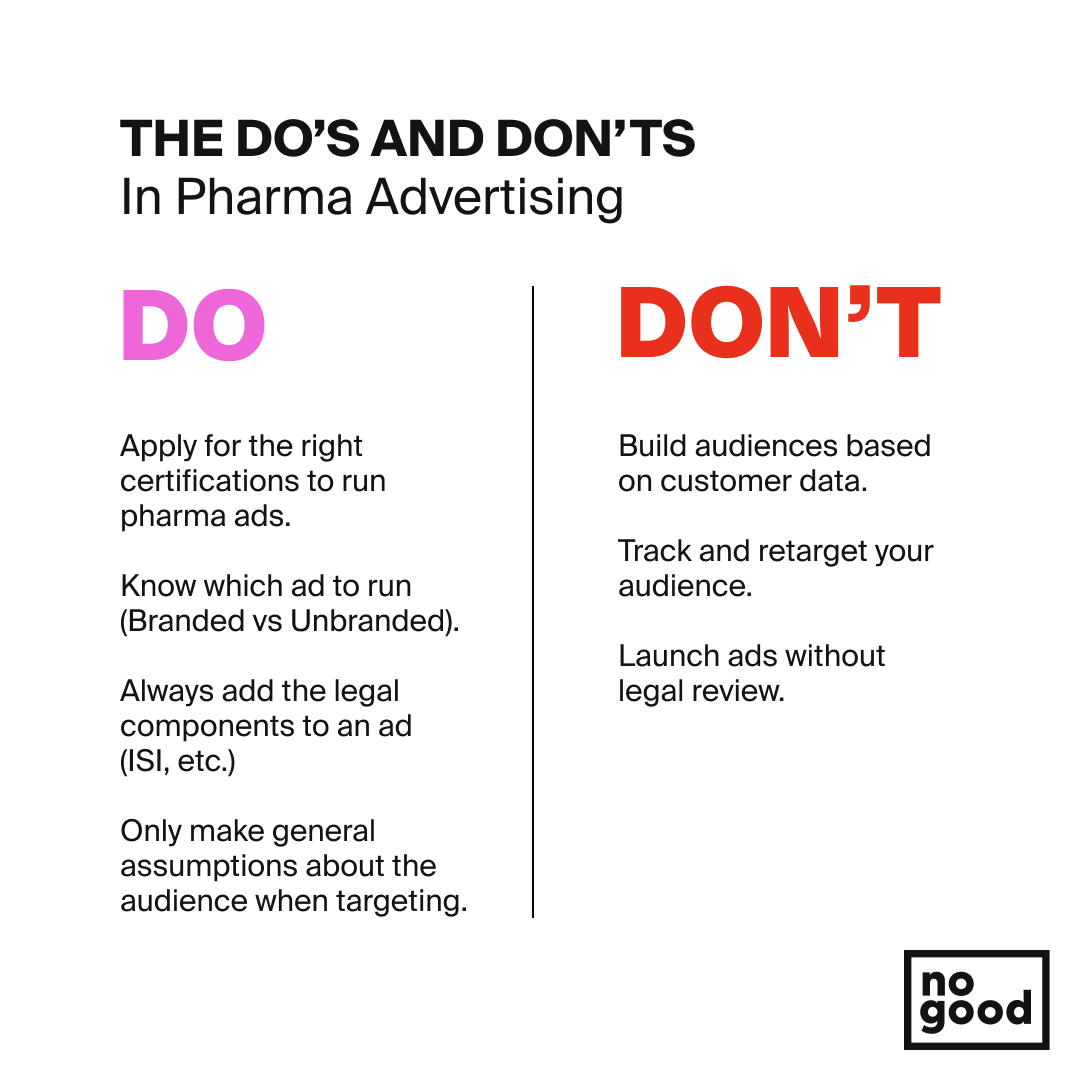
Digital Marketing Channels
Types of Channels & Nuances
When it comes to digital marketing, pay-per-click is one of the most powerful tools you can use for your pharma ads strategy. While there are a variety of marketing options available to you, most of them fall into the categories of paid search, paid social media, and display. In an ideal world, you would want to market on every platform. An omnichannel approach can result in a harmonious message that contributes to a better brand image, cost efficiency, and better results. Paid media advertising should be your top priority since it is a great way to support your inbound marketing strategy by collecting leads, increasing brand awareness, driving traffic to your website, or pretty much any other goal you have for your business.
Pharma Search Ads
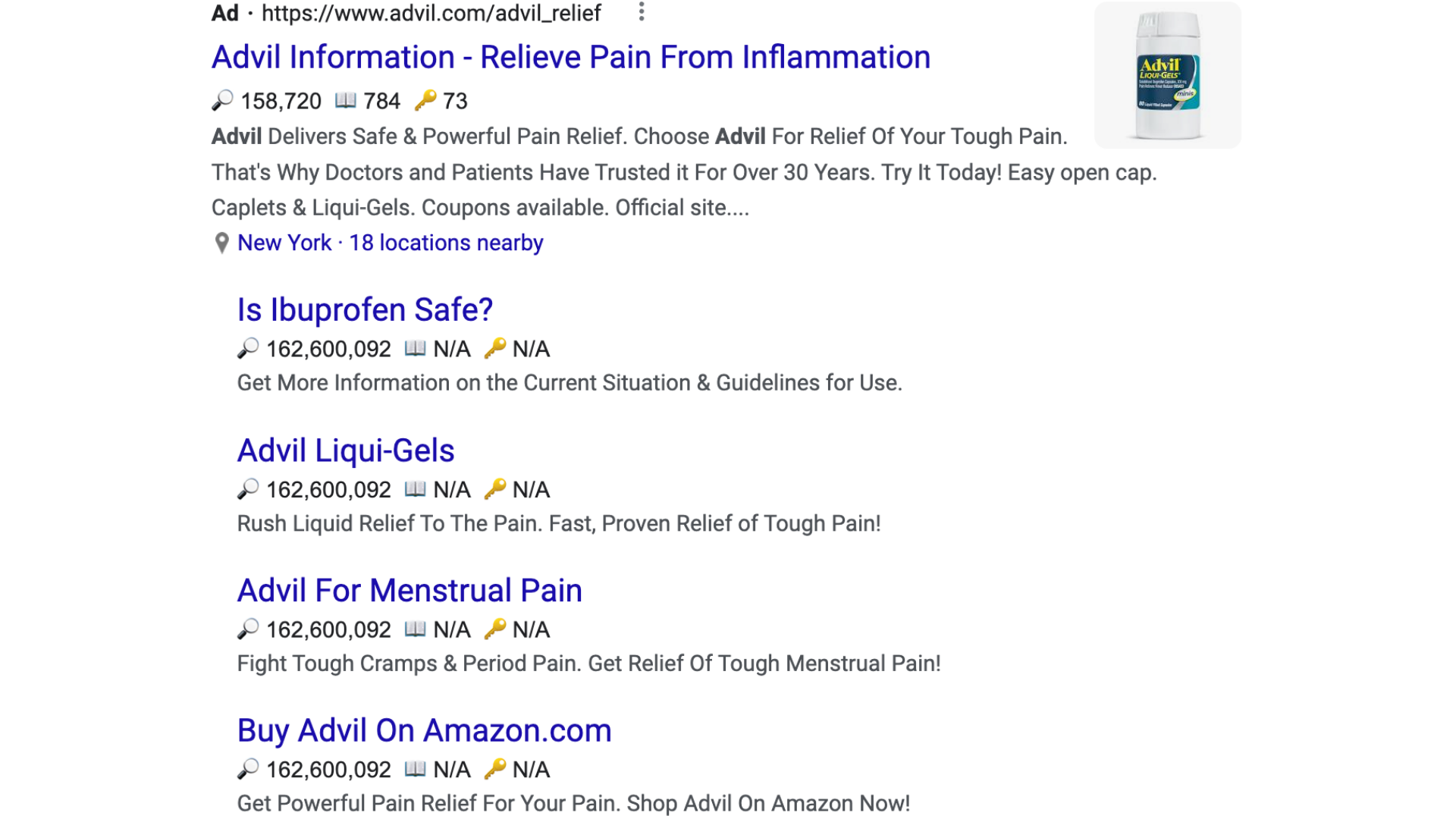
This type of ad gives businesses the opportunity to advertise within a search engine’s sponsored listings (SERPs results) or an affiliate site by paying each time the ad is clicked. Paid search platforms display ads in response to search queries. Some platforms that allow paid search ads are Google, which is the most well-known, Microsoft (formerly known as Bing), Yahoo, and others.
Search Engine Marketing (SEM) refers to a variety of techniques and strategies aimed at driving traffic from SERPs to the website. It is a broader term that combines search engine optimization (SEO) and paid search. Advertisers bid on keywords that users of services such as Google or Microsoft Bing might enter when searching for specific products or services.
Search engines are the first port of call for answering questions and finding solutions. When users search for symptoms, medications, or answers about their health, it’s a great opportunity for pharma companies to show up with relevant products. paid search ads can be an important part of a pharma brand’s digital strategy as they bring in a wealth of quality leads, sales, and patients.
What makes paid search unique is that it is an intent-based advertising channel, where your business targets marketing campaigns to people whose online behavior shows interest. When it comes to targeting people with high intent, paid search is hard to beat. You don’t have to convince people that they have a problem, because they already know it and are looking for the solution — you just need to convince them that your solution is better than the competition. For example, if someone searches online for “hair loss,” chances are they are losing hair and looking for a solution, so you want your business to appear as the first result on the search engine results page (SERP). Placing a paid search ad for that search term is the best way to achieve this.
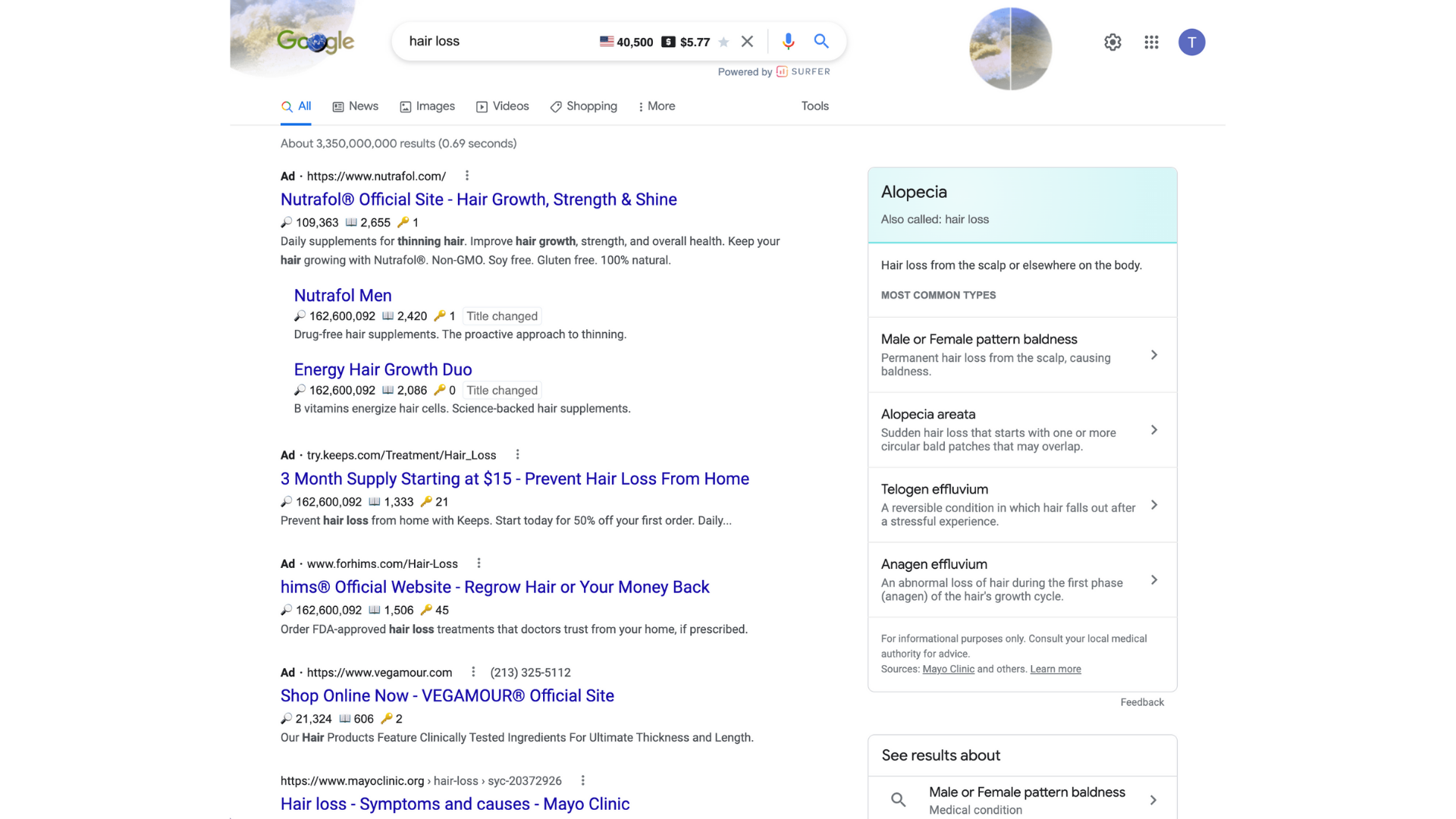
WHY USE
Paid search is a very effective way for pharma brands to reach their target audience, generate new customers, increase sales and reduce acquisition costs. SEM works by harnessing the power of search engines like Google, Microsoft Bing and Yahoo through paid ads to reach the right audience at the perfect time and place.
To understand the importance, it is important to know the benefits paid search offers.
- Reach a Highly Interested Audience
As mentioned earlier, SEM helps the business gain visibility and get quick results by reaching people with a high conversion rate. In SEM, you pay per click. So the keywords you target should make sense for your business, otherwise, you won’t see returns rather that you will lose money.
It is possible to create a campaign that encourages patients to seek treatment for the disease without mentioning a specific brand. These are known as unbranded campaigns. Unbranded pharma search advertising drives impact on brand and category conversion. This type of campaign gives pharma more regulatory flexibility since the published content is generally perceived to be more informational and educational rather than promotional.
- Increase Brand Awareness
While SEM is considered a bottom-funnel marketing channel, it can also increase brand awareness. Pharmaceutical brands need a strategy that uses both paid SEM and organic SEO to build authority and leave a lasting impression on users. Pharmaceutical companies can establish themselves as a trusted brand among potential customers when they show up for related search terms. The benefits of helpful ads include brand awareness and high-quality website traffic. This is especially important to reach mobile users because on mobile, paid ads often appear just above the fold on the screen, requiring users to scroll down to research organic search results.
Moreover, unbranded efforts can take the form of “disease awareness” campaigns which are designed to drive new patient diagnoses by educating patients about symptoms. Logically, these campaigns are more effective for diseases where a high proportion of patients remain undiagnosed.
- Create Geo-Targeted Search Ads
By creating geo-targeted search ads, the company takes control of where the ads appear. For example, with geo-targeting, you can target people in the US, in New York, and on the Upper West Side. That’s how specific geo-targeting ads can get, resulting in the company’s ads showing up in preferred locations. Pharma ads marketers can be successful online if they focus on location rather than the individual patient. For example, when aggregated prescription data is focused on the location of a trade area and not linked to patients or household addresses, individual privacy is protected. Aggregated prescription data is aggregated at a level that is always compliant with all privacy laws.
- Bid on Competitors’ Related Keywords
If you do it right, bidding on competitor keywords can boost your performance at SEM. That’s because when a user searches for your competitor’s products or services, you can assume they are also interested in what you have to offer. The benefits of bidding on competitor keywords are that there is less competition, as brand names usually have a higher cost per click, and you gain brand awareness when consumers search for a product or service that your competitor offers.
- Pay Only per Action
SEM gives you the option to pay only when certain actions take place, such as a purchase, submitting a web form, a phone call, etc. This assumes that the action goes beyond the click. With Cost Per Action campaigns, you set the goals that can be tracked and then pay when the goals are met.
Pharma companies face high competition for pharmaceutical terms, and creating a successful keyword strategy requires extensive research. With free tools like Keyword Surfer, Answer the Public, or Keywords Everywhere to paid tools like Ahrefs, SEMRush, or Moz, you can research keywords to better understand the search behavior and needs of your target audience and make informed decisions.
The general rules for keywords are the following:
- Avoid using the name of the drug or medicine as a keyword.
- Bidding on competitor keywords is a great way to get more views and traffic from people searching for a competitor. However, since this can be expensive, you need to make your ad look better by adding extensions and more engaging text.
- Long-tail keywords are more practical because fewer people bid for these phrases. However, if the keywords are too long-tail, the search volume will be very low, so try to find a balance in between.
- Avoid using keywords for drugs that treat the same problem but have different indications.
CHANNEL NUANCES
Domain Names — Search platforms offer pharmaceutical companies the option to use other domain names as their final landing page. These are called vanity URLs. This exception was set up specifically with pharmaceutical companies’ legal issues in mind. They now offer several domain placeholders in ads that hide the domain name so that it is not displayed. This allows you to run ads that do not mention the product, but talk about treatments and how a prescription can help with various health issues. This method allows you to target your ads to a broader audience. This is also something that they do not offer for other industries and is specific to the pharmaceutical industry.
Retargeting — Since pharma is a highly regulated industry, you cannot follow marketing strategies such as retargeting on search. This is due to the uniqueness of the products and services as well as patient privacy and data security. Most people value absolute discretion when it comes to their health, so being tracked by ads online is an issue. The Health Insurance Portability and Accountability Act (HIPAA) Privacy Rule gives individuals important control over whether and how their protected health information is used and disclosed for marketing purposes.
On-Site Analytics — In e-commerce companies, we measure success by sales. In digital marketing, you know exactly how every dollar was spent that resulted in revenue. In pharma ads, it’s really hard (sometimes impossible) to know when the final sale happens. To optimize and test the effectiveness of your paid search campaigns, you need to monitor on-site analytics. Statistics like page views, average session duration, or on-site conversions (i.e. PDF downloads) can help better manage your campaigns.
Regulations — Depending on the location and product, the platforms regulate which pharmaceutical companies are allowed to advertise. Before an ad can be placed, all pharmaceutical manufacturers must be certified (Google Ads, Microsoft Ads). These platforms however allow health content in certain circumstances. Some content is only available to specific regions, so before advertising, make sure to check the list of country-specific restrictions (Google Ads, Microsoft Ads). To ensure a safe and positive experience, ads, extensions, and other content that violate their policies can be blocked on their platforms and associated networks.
As a business that sells health-related products, you need to be aware of these regulations before you launch your ad campaign on these paid search channels, as they do not verify the legality of the content of your ad. Therefore, it is your company’s responsibility to understand and follow the applicable laws and regulations. Since you’ll be able to run ad campaigns across the paid search and display partner networks, you’ll want to make sure you are compliant with pharma ads regulations regardless of format.
For example, responsive display ads automatically adapt to a variety of spaces. This means you need to make sure that the creative elements you use will stand up to legal scrutiny, even if the size and shape of the ad change. Also, the platforms may truncate some of the text in a responsive ad. So make sure your legal team reviews all potential variations of your ads before launching the campaign.
Video Advertising
Digital transformation in the pharma industry has accelerated spending on video across all devices. Both vertical spending and video spending in pharma are expected to increase 11% and 19% year-over-year, respectively. With changing media consumption habits, media buyers are testing and experimenting with different combinations to maintain viewability and target key audiences. Due to the intricacies of regulations for pharmaceutical paid media advertising, it is important that each campaign is carefully designed to include precise targeting and numerous other legal considerations.
WHY USE
- Video Ads Have Higher Engagement
Video ads combine two things that attract users’ attention: Motion and sound. Both play an important role in delivering an effective message and therefore lead to higher engagement. While image or text ads rely on text, punctuation, and visual cues to convey the desired tone, video ads use motion and sound to capture visitors’ attention. The ad format is more effective in delivering a tailored message that is easy for the target audience to consume.
- Video Ads Have Higher Click-Through Rates
The fact that video ads tell a better story than typical banner ads means that the former is not only better at engaging audiences but also gets more clicks. According to a study conducted by Smaato, the average CTR of video ads in mobile apps is 7.5 times higher than display ads. Facebook video ads also have a higher CTR than image ads. ClearPivot, a digital marketing agency, found for their clients that video ads get exponentially more clicks than image ads, by 20% to 30% more clicks.
- Transform Video Ad Clicks Into Conversions
With video ads, advertisers can better engage their audience and get more ad clicks. You can use ad platforms like Facebook and YouTube to create a variety of video ads.
CHANNEL NUANCES
Create Platform-Agnostic Assets — In any industry, short videos allow for better scaling and more efficient performance. More specifically, assets under 60 seconds have the most available inventory. Producing short videos can be difficult for pharma companies, especially prescription brands that need disclaimers that affect length. Pharma banner ads are required by federal law to include important safety information (ISI) and warnings about the benefits, efficacy, and potentially risky side effects of the drugs. This information must be included directly in the ads themselves, resulting in 33 and 50 percent of pharmaceutical banners being taken up by ISI text.
QR Codes or customized CTAs can be an effective solution to encourage users to visit the site while making room for important safety information on the screen. If only one video asset is available, use the highest common denominator specifications to create a video that works on multiple screens.
Targeting — Condition-specific targeting in pharma ads are essential. However, patients are more than just their condition, and advertisers must also consider other targeting signals. Not every partner can capture health data segments, and while they are an essential part of any pharma ads campaign, they are often not as effective. To combat this and maintain a well-rounded targeting strategy, it is suggested to use segments based on TV, social media indicators, and other lifestyle-related data.
Brands are already working on ways to handle the cookieless future. That is why companies need to make sure that providers are using privacy-safe, consenting audience sources based on alternative forms of identifiers and a healthy mix of data types (second party, zero party, and/or first party).
Tailored Ad Performance Measurement — The disclaimer included in pharma videos reduces the likelihood that a consumer will watch the entire video. If the most important KPI is full views, opt for non-skippable and CTV environments. The length of the asset and individual campaign goals can determine which metrics are the best indicators of performance. Perhaps, the KPI should not be full views for any video ads campaign, but rather a view-through of the core brand message that you’re trying to convey.
Pharma Display Ads

Display ads come in many shapes and sizes and can be presented in a variety of formats, including banner, interstitial (interactive, full-screen ads that cover the surface of the host app or website), native video, or rich media (with enhanced features such as video, audio, or other elements). Another benefit is that you can access billions of websites directly from your Google Ads account, thanks to the Google Display Network (GDN). The broad reach of the GDN allows pharmaceutical companies to target ads based on demographics, geography, specific interests, and websites related to your business. An example would be targeting a site that relates to your specific industry or niche so you reach a more qualified audience, and blocking certain sites so your ads do not appear on unrelated pages.
WHY USE
Regardless of where display ads are placed, they need to be optimized to target specific audiences, and it’s best if they are linked to a custom landing page. The reason for this is that once landing pages are clicked, they need to be optimized to be dedicated to only one offer, like the one promised in the ad. Although display ads have a lower click-through rate, the cost per click is usually lower and brand awareness is effectively increased. The benefits of display advertising are many, as it can be placed on almost any type of website and is a great way to reach relevant audiences. Here are just a few to mention:
- They Are Targeted
Display advertising offers pharmaceutical companies a unique opportunity to focus on their ideal target audience. Your brand can choose which websites you want your ads to appear on, which geographic region, and which audience you want to target. The benefit is that you can optimize your spending and ensure you are advertising to the right audience.
- High Yield in Brand Awareness
As great as paid search is at getting people to buy your product, it’s important to increase awareness to build a loyal following so people buy from you when they have a problem instead of looking online for another solution. By increasing awareness, you are trying to target an audience that is further up the marketing funnel, which is why display advertising and paid social media work great. With these forms of advertising, you can promote your product and tell a brand story with images, reviews for your pharma products, or video content that grabs people’s attention.
- Cost-Efficient
When funds are tight, it’s only natural to look for low-cost advertising options. In terms of pay-per-click advertising, display advertising is an easy winner as it is one of the cheapest options. Pharma benchmarks for cost per click (CPC) are $3.17 for paid search, $1.32 for paid social, and $0.37 for display advertising. However, display advertising and paid social advertising are higher funnel options, meaning it takes a lot more effort before someone converts, as opposed to paid search, which has a higher intent.
CHANNEL NUANCES
Personalized Advertising — The Google Display Network reaches 89% of Internet users worldwide, across millions of websites. Most of the challenges pharma companies face are related to personalized advertising. According to Google, advertisers cannot serve ads to users who fall under sensitive interest categories, such as sexual interests, abortion-related ads and more.
ISI Creative Constraints — Display ads must include important safety information (ISI) and warnings about the benefits and potential risks of the drugs. If you try to present a balance of benefits and risks, 30-50% of the ad space will be taken up by the notices.
Make the most of your ad space by adding a scrollable ISI. Add color to the scroll arrows so users know they can scroll and that there is important information to read. If your ad consists of multiple frames, add a repeat button to allow the user to replay the content.
Personalized Advertising Restrictions — On the Google Display Network, most of the challenges medical devices and pharmaceutical companies face with Google Ads are related to personalized advertising, which Google defines as ads that “use online user data to target users with more relevant advertising content.” Under the personalized advertising guidelines, advertisers are prohibited from serving ads that fall into “sensitive interest categories,” such as personal distress, identity and beliefs, and sexual interests.
Brand Recognition — Your company’s display ads can appear on sites across the Display Network. If they are already familiar with your brand name and logo, you can use display ads to effectively provide your customers with new information about diseases or other data.
Paid Social Advertising
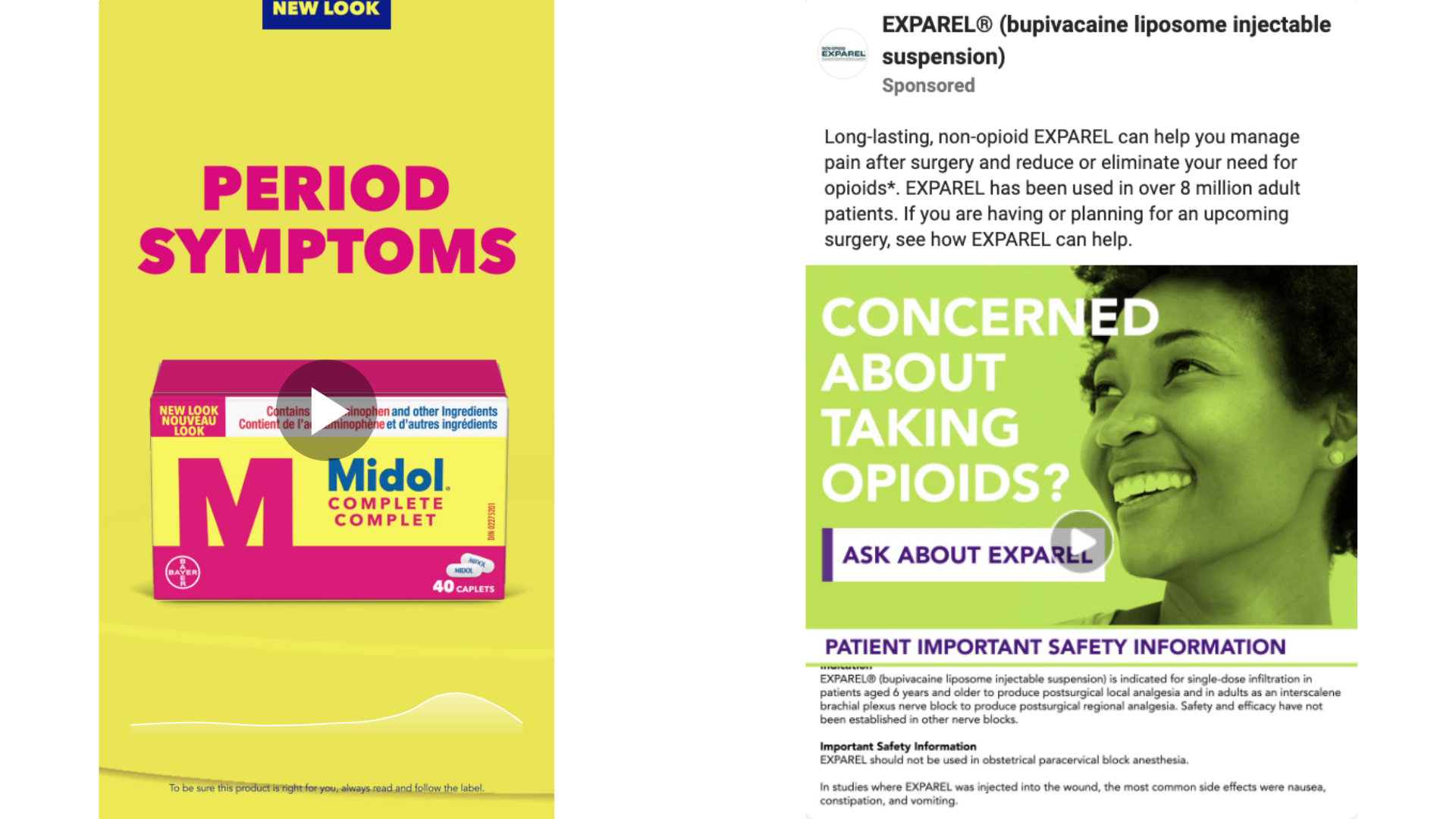
Advertising on social media gives brands instant visibility; it fits into any budget, increases awareness, maximizes content marketing, and improves audience targeting. Although you cannot use retargeting lists in your pharma ads strategy, you can highly target your marketing efforts if you opt for pharma ads. Aside from the demographic and geographic targeting, you can achieve with paid search and display advertising, you can advertise on social media based on specific interests, behaviors, and habits.
WHY USE
According to Statista, the number of people using social media is over 3.6 billion worldwide by 2021, and these numbers are expected to continue to grow as more underserved markets gain access to mobile devices. The top 3 reasons are as follows:
- Increase Brand Awareness
Knowing who your audience is can go a long way on social media because you can target them with tailored content. They say a picture is worth 1,000 words, and that’s why visual content can grab a user’s attention much more than a text ad. When it comes to online content, video is king. Many pharma companies have already taken this to heart and are using video to help more patients access the treatment they need.
Good use of video ads can also increase sales for doctors by enabling properly informed patients to make suggestions to doctors about a particular brand. When doctors see a high demand for a product, they are more likely to prescribe it on their own. Videos have a great impact when used to explain how a particular product works. If you explain in detail how a drug works on a molecular level and cleverly use the first 10 seconds to hook people, you are more likely to get a higher conversion rate.
- Generate Leads
One of the most important benefits of social media is that it is a great way to generate leads and introduce people to your brand. It is commonly used by pharma companies to boost their business by targeting physicians. Using social media analytics, you can easily find out what people are most interested in and what you offer. If you offer proprietary content that requires an email address, you can start generating leads. Lead forms are another good option. When visitors open the form, they can provide their contact information such as email address, phone number, and other details. However, lead forms usually have a higher cost per acquisition (CPA), and it’s a good idea to direct visitors to the website to fill out the form.
- Boost Sales
Social media can help show people what products you offer in an easy and fun way. People are increasingly using social media to find products and companies. Pharmaceutical and biotech companies, as well as Silicon Valley startups, have already realized the power of social media platforms and are additionally using influencer marketing to increase their sales. By engaging influencers, they can help tell stories that give social media users a sense of how healthy they can be.
CHANNEL NUANCES
Facebook & Instagram Ads
The Power of Community — After years of shunning social media, pharma companies are getting bolder and increasing their ad spending on social media. Facebook and Instagram have opened up new advertising opportunities for the industry by offering tools to help drugmakers comply with regulations on disclosing safety information or reporting side effects. By promoting OTC medications and non-prescription medical devices, your brand can connect with consumers on a large scale by harnessing the power of social media marketing.
Hyper-Targeting Capabilities — Facebook’s targeting system and wide reach can help you advertise efficiently and grow your brand. Facebook’s interest targeting features allow advertisers to focus on audiences within specific interest groups, such as medical conditions. This is highly beneficial to the pharma industry, as it allows ads to be shown almost exclusively to people who are interested in their product. Hyper-targeting, where you clearly identify a target audience and deliver extremely relevant messages, saves campaign costs, provides better data, and enables precise messaging.
Push User-Generated Content — Incorporating user-generated content (UGC) into the pharma ads sector seems impossible. However, nowadays it is a big trend, as UGC builds trust and brand awareness across consumers. Patient or HCP testimonials are one of the most popular contents on video. Personal testimonials or real-life patient success stories are popular video content. According to reports, about 92 percent of users rely more on personal recommendations from strangers and acquaintances than on information and advertising messages from the brand itself.
There are some key steps involved in strategizing for Facebook Advertising, and you can read them all here.
A Gold Mine for Brand Awareness — Although Twitter is tightly regulated by the FDA, it is an important social channel for pharma ads strategies and offers a gold mine with great potential to increase awareness. Twitter Ads are the perfect complement to an organic content strategy. The promoted, paid content you create in your campaigns will appear as Promoted Tweets and/or Promoted Accounts — and will be presented to a wide audience of your choosing to increase awareness and visibility.
Microblogging — Of the social media platforms, Twitter marketing is particularly complex due to its short lifespan and demanding character limits. Microblogging is a compressed messaging format where a limited number of characters can be sent in a public or private feed in real-time. Twitter allows up to 280 characters and can include text, photos, graphics, and videos. Considering that many simple advertising formats are available and no minimum advertising budget is required, now is a good time to consider adding Twitter to your social media marketing strategy.
Regulations — Twitter has a clearly defined policy for the pharmaceutical industry regarding its paid advertising products, i.e. tweets, trends, and accounts. The rules on this platform for pharma ads vary depending on the product and country the campaign is targeting. If you are interested in pharma ads on Twitter and need approval, you can contact them here.
TikTok
Original Content — One way the pharma industry can use the platform is through the use of original content. There is an opportunity to make scientific information more understandable and accessible to their audience. Because TikTok is a short video platform that emphasizes simple and authentic production quality, it is the perfect opportunity for pharma brands to publish simple, bite-sized information to help users understand complex topics. On TikTok, healthcare providers and health-related communities can also share up-to-date information about research, spread disease awareness by sharing personal/patient stories or even award their peers.
Creator Partnerships — Creator partnerships are also a great way pharmaceutical brands can utilize the video-first platform. TikTok’s Creator Marketplace is a great place to start the journey to see which creators are best to partner with for a campaign. There’s also the opportunity to partner with the healthcare professional audience to amplify a campaign’s message if it’s a part of a greater purposeful message like spreading disease awareness or taking a stance against injustice, instead of simply pushing products.
Age-Targeting — Marketers should not shy away from using as many ad formats as legally possible to increase their brand’s exposure. However, it’s important to note that some formats are age-restricted, which could affect access and reach for certain pharma brands.
Expert Tips to Get Started
Paid media can get you to the top of search engines, social media feeds, and more. Without an effective strategy, you can not achieve successful results and you are basically wasting money. When running paid media campaigns, it’s important to test regularly and look for new ways to optimize your results; especially in pharma, where ads are plentiful. It’s important to consider the following three tips before you launch your campaigns.
- Branded vs Unbranded Campaigns
The U.S. is one of the few countries that allow direct-to-consumer advertising of prescription drugs. According to Search Engine Journal, over 25% of people click on the first Google search result, so being on the first search engine results page (SERPS) is critical. As mentioned earlier, ads must include both the brand name of the drug and its “indication” as well as a balance between the positive and negative effects of the product. According to the FDA, a balance is not required for ads that do not mention the drug by name. Therefore, it is possible to create a campaign that encourages patients to seek treatment for a condition without naming a specific brand. Such campaigns are referred to as unbranded campaigns. In addition, branded campaigns that mention the name of the brand and product can be effective and are more likely to lead to a direct result
Unbranded campaigns are usually appropriate for raising awareness and promoting new patient diagnoses by educating patients about their symptoms. However, because this is an unbranded campaign, it is unlikely that patients who are motivated to take action will ask the doctor for your specific brand name. However, if a conversation in an unbranded campaign resulted in treatment, the doctor would be more likely to recommend the product with the highest market share. For example, if your product only has a 10% market share, patients activated by an unbranded campaign will only receive your product 10% of the time. On the other hand, if a competitor has a 50% market share, patients activated by the campaign will receive the competitor’s product 50% of the time. The ideal scenario for an unbranded campaign would be a product with a high market share and a high proportion of undiagnosed patients.
In contrast, branded DTC advertising creates specific patient awareness of your brand name. If a patient asks for your brand’s drug because of a brand campaign, a doctor will (hopefully) prescribe it. Brand campaigns can be more effective in situations where the condition is not very serious, such as skin conditions. In such cases, doctors are less likely to choose one product over another, and they will most likely give patients what they want, or what’s more affordable. Branded DTC campaigns work best for drugs where the balance is minimal and where the risks to the physician in prescribing are minimal.
- Create Custom Landing Pages
A recent study from the College of Technology suggests that our collective attention span is decreasing, and this effect is not just occurring in social media but is affecting various areas such as web searches, books, and more. There are so many things that occupy our attention that we can only focus on new “trends” for a short period of time. In fact, on average, users only read about 20% of the text on a page. Furthermore, the average page visit lasts less than a minute and users often leave web pages after 10-20 seconds.
The good news? There are still ways to engage your audience:
- Pages with a clear value proposition can hold users’ attention much longer. To capture a user’s attention for several minutes, you need to clearly communicate your value proposition within 10 seconds.
- Optimize your page load time. Google recommends that your page load time should be under 3 seconds. A faster page equals a better user experience, and Google will reward you with more favorable bids for your ads.
- The keywords that are bid on in paid search campaigns should all (or most) be present on the landing page.
- Include text that thoroughly explains and supports all claims in the ad message.
- Include clear calls to action to help your users convert.
- Optimize for Mobile Users
When you create paid search campaigns, ads should be able to be found not only at home (on desktops), but also while waiting in a doctor’s office, in the car, and more. If your campaigns are not mobile-friendly, you are missing out on potential prospects, patients, healthcare providers, etc. It’s important to create an optimal user experience and rank on Google’s search engine results page (SERP) because Google has optimized mobile compatibility for its paid search algorithm.
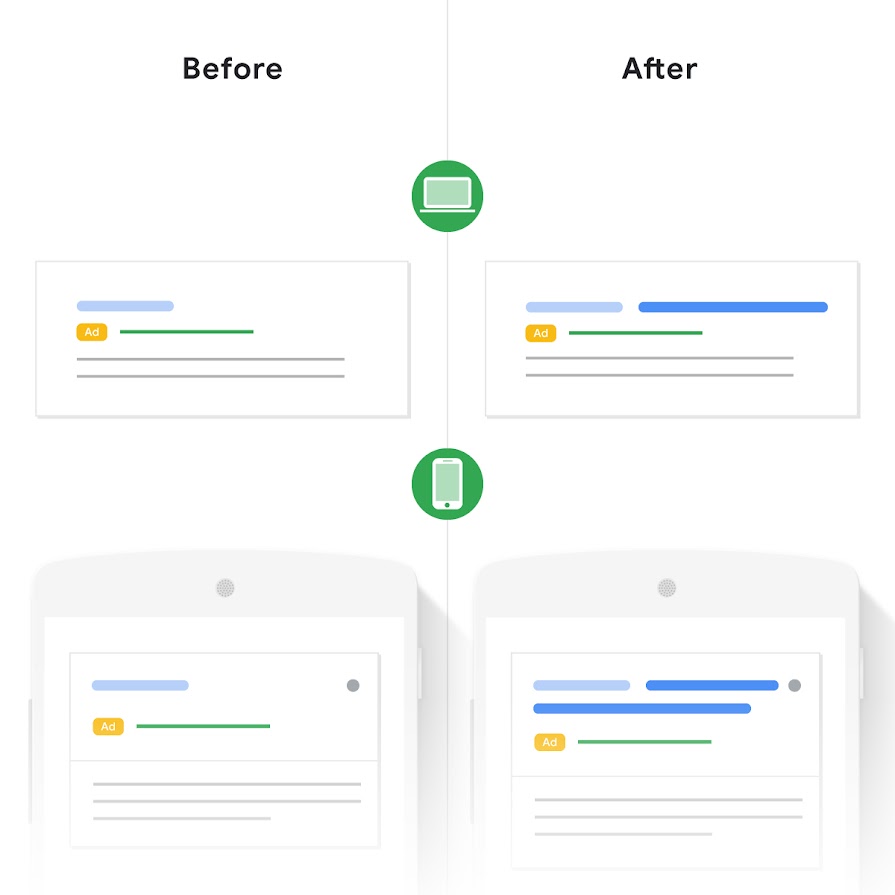
- Run A/B Testing
A/B testing (also known as split testing) is a randomized experiment in which two or more variants of the same ad (A and B) are shown. Variant A is the original and B may contain at least one element that is modified from the original. You can run this experiment simultaneously and then analyze which variant performs better. You should compare the ads by headlines, descriptions, links, and keywords used.
In Summary
In summary, for every type of medical issue consumers have, there are many pharma companies with drugs to treat it. You want to make sure that people prefer your brand over the competition. Successful pharma ads can help build a positive reputation for the company. Unlike the research and development (R&D) departments of a pharmaceutical company, which are critical to turning an idea into reality with a drug molecule, marketing is responsible for breathing life into a product.
If you are looking for a growth marketing agency that can take your pharma ads strategy to the next level, you can learn more about NoGood here.
